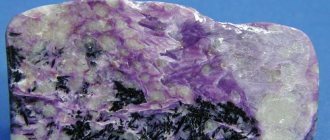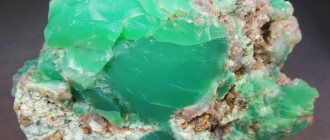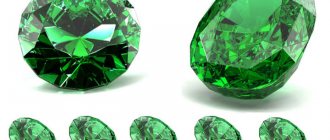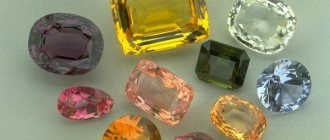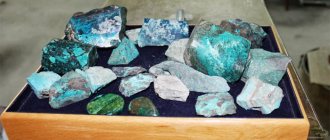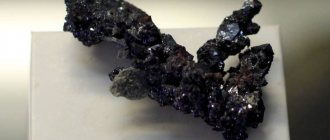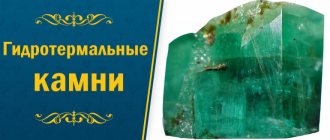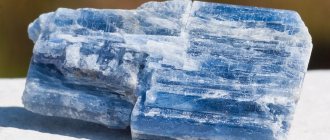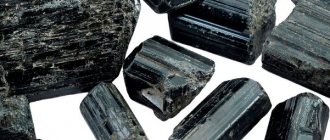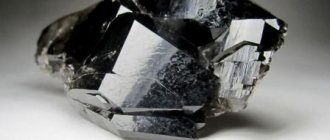The azurite stone, which gets its name from the French word azur, meaning “azur,” bears its name for a reason. This is the only way to call a sky-blue mineral endowed with a beautiful glassy sheen and amazingly smooth edges.
Azurite is a mineral endowed with a number of unique properties: first of all, the ability to boil in hydrochloric acid, and also the ability to transform into malachite (a very valuable bright green mineral).
Azurite stone - origin story
Over the centuries, azurite has changed its name more than once. In France, it is still called chessilite (in honor of the town of Chessy, in the vicinity of which these beautiful gems were mined for a long time).
The stone received its current name in 1824 thanks to the French mineralogist Francois Beudan. The mineral has many synonymous names that have survived to this day.
It is known to some as “copper blue,” “mountain blue,” “copper blue,” or “copper lapis.”
Since ancient times, azurite has been used by Irish shamans and Egyptian priests as a material used to make magical amulets and religious objects.
European painters, who created their canvases in the 15th-17th centuries, widely used bright blue paint made from azurite, ground into powder. The ceiling of the Sistine Chapel is painted with the same paint.
Physical properties
Azurite, striking in its variety of rich shades of sky blue, is a natural mineral, a subtype of copper ore. Its crystals have smooth edges and a characteristic glassy luster.
Deposits of this mineral are concentrated in places where copper and polymetallic ores occur, the oxidation of which leads to the formation of columnar crystals of azurite, which can be transformed over time into precious malachite.
- The chemical composition of azurite, as can be seen from its chemical formula – Cu3(CO3)2(OH)2 – includes copper carbonate and hydroxide anions.
- The rich blue color of the mineral is due to its high (at least 55%) copper content.
- The mineral is quite fragile. Its hardness range on the Mohs scale is 3.5-4 units, and its density is 3.8 g/cm3.
- Azurite has a conchoidal fracture and perfect cleavage.
Lazulite
The next one is iron-(magnesium)-aluminum phosphate, called lazulite. Its blue color, as a rule, has a cooler shade than that of classic lapis lazuli, although very bright examples are also found. In this mineral, some of the iron ions are usually replaced by magnesium ions. The blue color is due to the presence of iron, and magnesium weakens and extinguishes the azure color. Most often, lazulite is found in the form of granular masses in quartz or pegmatite veins, but sometimes transparent pyramidal crystals are found, suitable for jewelry cutting. So far, geologists have not found a single truly large deposit of this stone, but the most impressive examples to date have been found in Canada, in the Yukon Territory.
Lazulite from Yukon, Canada Photo: Wikipedia
Lazulite crystals in quartzite rock Photo: Wikipedia
Place of Birth
The richest azurite deposits are located in:
- USA;
- Chile;
- Mexico;
- Australia;
- Germany;
- France;
- Kazakhstan.
The largest and highest quality azurites are mined in small deposits of South and North Africa, located in:
- Namibia;
- Morocco;
- Zambia;
- Zaire.
In Russia, the supplier of unusual types of azurite is the Gumeshevsky copper mine, located in the Southern Urals.
Mining locations
Azurite is one of the minerals common in nature. It is found in the same places as other copper ores, as well as native copper or malachite.
The deposits are located in the Russian Urals, Altai (including Kazakhstan), in the USA (Arizona), Australia (Queensland, Burre), France, Great Britain, Greece, as well as in many African states, rich deposits of jewelry and semi-precious stones. Among them are Namibia, Congo and Morocco.
Varieties, colors
Azurmalachite
In its pure form, azurite is extremely rare, because, attracting other rocks lying nearby, it grows together with them, forming unusually beautiful crystals, striking in a variety of shades and colors: from dark blue and bright blue to rich purple and almost black.
Depending on what rocks the azurite crystals are fused with, they are distinguished:
- azurmalachite is a mineral formed by the fusion of azurite and malachite;
- burnite - a rock formed as a result of the fusion of azurmalachite with cuprite;
- blue copper is a mineral obtained by merging crystals of pure azurite and chrysocolla.
Physico-chemical properties of azurite
Azurite tumbling.
Photo: www.sagegoddess.com Azurite is a natural carbonate characterized by a low Mohs hardness and high density. Due to its fragility, the material is practically not used in jewelry in its pure form, preferring combinations of azurite with stronger rocks. In the Middle Ages, azurite was used as a mineral pigment to create tempera paints. In modern times, the element has found a new application - in pyrotechnics: copper cations, which are part of azurite, give the fire a pleasant green color.
The stone is distinguished by a rich blue or blue color, which can fade if not properly cared for. This mineral has a glassy luster and smooth edges.
Azurmalachite, which is a mixture of blue azurite and green malachite, is popular, which is possible due to the tendency of azurite to grow together with other rocks. Thus, stones of various shades arise: from deep indigo to pleasant black with a purple tint.
Pendant with azurmalachite
How is it different from lapis lazuli?
People who do not understand mineralogy often confuse azurite with other rich blue minerals, most often with lapis lazuli.
These outwardly similar stones can be distinguished by a number of characteristics:
- The color of azurite is more rich and deep. The bright color of lapis lazuli is emphasized by golden inclusions of pyrite, sparkling in the sunlight.
- Lapis lazuli is a harder stone. A copper coin will not leave a scratch on its surface, while azurite can be easily scratched by both a coin and a knife.
- On the rough surface of a white porcelain plate, when worn away, lapis lazuli leaves a bright blue line, while azurite leaves a sky-blue line.
Types of azurite
Pure azurite crystals are quite rare, since this stone is characterized by binding with other minerals. Thus, in nature there is azurmalachite, a combination of malachite and azurite, burnite, containing azurmalachite and cuprite, blue copper, which consists of azurite and chrysocolla. Thanks to these properties of azurite, crystals of blue, purple, almost black color are formed.
Types of stone
The mineral azurite has an interesting ability to attract other rocks. Fusing with them into one whole, initially pure, it turns into a completely different stone with an admixture of new colors and shades.
For this reason, pure azurite is almost impossible to find. In natural conditions, the following types are found:
- blue copper, which is a mixture of azurite and chrysocolla;
- azurmalachite – as you might guess, in this case azurite crystals grow together with malachite;
- burnite – but this subspecies can be considered the most diluted azurite, because it arises as a result of the fusion of already mixed azurmalachite with cuprite.
Azurmalachite
Its most common neighbor is malachite. The depth of blue and the sophistication of green look great in tandem. This breed received its own name - azurmalachite. It is from this type of stone that most jewelry is created.
Azurmalachite
Benite, burnite or "bluebird"
All these names refer to the same type of azurite, or more precisely, to its subspecies - azurmalachite, enriched with cuprite. This variety is usually ignored by jewelers because it is too soft and does not polish well.
Bornite
"Blue Copper"
This species is the result of the fusion of pure azurite with chrysocolla. It is distinguished by the brightest and most saturated blue color.
Blue copper
Azurite in granite
Another tandem option is when azurite is an admixture of granite. Its blue color, creating intricate patterns, looks incredibly beautiful against a gray background.
Azurite in granite
Magic properties
In terms of energy, azurite is an example of the manifestation of feminine Yin energy. Having faced the influence of negative energy and passing it through itself, the gem makes this energy positive.
The magical properties of azurite were already known to the priests of Ancient Egypt, who used it as an intermediary during sessions of communication with the gods.
Azurmalachite, which combines the energy of two minerals at once, is endowed with double strength. Malachite, which is part of its composition, frees the human body from negative emotions, while azurite normalizes energy flows, reflecting the impact of negative energy.
During meditation, placing azurite on the crown chakra, one gets rid of adversity and anxiety, which are the culprits of strong internal experiences, ultimately finding complete harmony with both the inner and outer world.
A person who is faced with a difficult choice of a further path and does not know which direction to go can put on jewelry with azurite and wait for a hint.
The stone will certainly show you the right path to help you either avoid serious problems or solve them in the most optimal way.
Mediums and psychics highly value azurite balls, which help them in conducting meditations and spiritualistic sessions, during which the gem plays the role of an intermediary between the consciousness of its owner and his subconscious.
The rich blue color of azurite crystals stimulates the crown chakra (the so-called “third eye”), which promotes the development of logical, conceptual and tactical thinking, therefore the impact of jewelry made from this stone is beneficial for lawyers, judges and lawyers.
If the owner of azurite behaves immorally, allowing himself to commit bad deeds, the stone stops giving him its positive energy and may close, and in some cases even split.
Scope and scope of use
Many collectors prefer azurite due to its deep blue color, natural luster and crystal shape, which are similar in appearance to lapis lazuli. The substrate itself can be green, gray or brown at the same time, it all depends on their varieties and the place of extraction. Impurities will also play an important role. The collection containing the azurite ore is especially valued. Nature rarely spoils people with such unusual and at the same time rare minerals. Such a deep shade was achieved thanks to the presence of natural inclusions.
Natural stone, which has a deep blue color, boils in hydrochloric acid.
In jewelry, this mineral is often replaced with malachite, as a more resistant copper carbonate. Various pseudomorphoses are also valued by collectors, because the cost of such products is very significant. In this case, any cutting method can be used.
The scope of its application is quite extensive. So, knowledgeable people use it as the main element that improves psychic abilities. It is also used in predictions and fortune telling. On its basis, magic balls and search crystals are made, which are involved in meditation. Can cure many other diseases. Personal contraindications should also be taken into account.
Magical indicators of azurite
Since ancient times, the stone has been used when a person sought to expand his own consciousness. Perfect for developing new abilities and if you need to rethink your own life. At the same time, it does not matter what shape it will be cut into. Belongs to the category of minerals that can influence the human subconscious. However, such thoughts must be beneficial, otherwise the stone will not help.
Based on the legends of Ancient Egypt, with the help of this stone the priests communicated with the gods. The mysteries of Ireland are based on stories that azurite sticks helped to experience previously unprecedented feelings. A small group of these stones should always be kept in the house, but they should be interacted with regularly. Otherwise, they may die.
Helps and protects representatives of such professions as journalists, lawyers, judges and lawyers.
The stone also helps restore justice. If a person deliberately tries to harm another, then the stone will not help and may even hinder such an owner. Suitable for all those who are inclined to become justice. Fraudsters are exposed quickly, so they will not be able to make money with its help, as was the case in ancient times. In a difficult situation, it will contribute to making a balanced and correct decision.
Adding a bit of balance, composure and patience will help all motorists who are stuck in boring traffic jams for a long time.
The stone will bring the necessary luck to its owner even if the dense gem is at home. It is not recommended to use foreign stones that have previously been used by other people.
Interaction with zodiac signs
Numerous legends tell many different stories about azurite jewelry, which are often passed down through generations. It is not used as often in famous brands, but this is most likely due to its extreme rarity. The aura of the stone implies the presence of feminine Yin energy in it. It is recommended to use as talismans and amulets for all air signs of the zodiac (Aquarius and Libra). He makes best contact with Libra, who can always count on his help. Other experts say that it is best suited for Taurus and Sagittarius. Compatibility with other zodiac signs has not been revealed.
The element of stone is water, but Jupiter is considered to be a planet.
Medicinal properties
The stone has various uses, but most often, based on numerous beliefs and legends, it is used to treat headaches (by applying the mineral to the source of inflammation) and cervical ailments. Also used for inflammation of the respiratory tract, hearing and throat. The stone should be used in meditation. Such manipulations are extremely useful both in the morning and in the evening.
The treatment goes like this:
- a mineral or decoration with its addition is applied to a sore spot or the location of an inflamed organ;
- then you should feel the energy of the mineral with your eyes closed;
- ask the stone for help in treatment;
- present the treatment process in great detail;
- visualize the upcoming process.
Azurite jewelry
The lack of hardness, as well as the degree of grain size of azurite, will depend on the location of the crystal deposits. Jewelry with inserts made of this mineral is extremely rare on the open market. They are also difficult to find in nature. It is not recommended to wear them on your hand, since the stone is not able to survive even minor mechanical impact. Its color cannot be called stable either.
The chosen frame for the stone will serve rather a protective function. A properly selected edging will help strengthen the already fragile mineral and prevent it from breaking at the first blow. In ancient times, it was worn only with very expensive outfits that were affordable for the local nobility.
Early on, stone was used as an ornamental material. Azur-malachite, which is not so fragile and no less beautiful, is considered no less beautiful. Regardless of where the stone is mined, it is incredibly fragile.
Medicinal properties
Since the energy of azurite is quite strong, lithotherapists do not recommend wearing it continuously for a whole month. After wearing it for three days, the jewelry with the stone should be removed and take a two-week break.
The healing properties of azurite allow it to be used for:
- Improving the composition of the blood and cleansing it of impurities.
- Reducing blood pressure.
- Relieving emotional stress.
- Accelerating the healing process of broken bones and soft tissue healing.
- Treatment of hysteria and epilepsy.
- Therapy of bronchial asthma.
- Treatment of skin diseases (including psoriasis and eczema).
- Improving vision and correcting some eye pathologies.
- Relieving pain accompanying arthritis and joint diseases.
- Treatment of diseases of the gastrointestinal tract, spleen, liver, bladder.
- Improvement of the endocrine system.
- Eliminate dizziness, relieve headaches, treat migraines.
- Normalization of the state of the nervous system, as a result of which the patient’s insomnia disappears, the feeling of causeless anxiety, depression and depression disappears.
The essence of the therapeutic sessions is extremely simple: during the procedure, pieces of the mineral are applied to the problem area of the body and left for several minutes. To enhance the therapeutic effect, lithotherapists recommend using azurite twice a day for meditation.
Who is suitable according to their zodiac sign?
- As a talisman, azurite (regardless of color) is ideal for representatives of the zodiac constellations Aquarius and Libra . The gem will help them develop intuition and learn to recognize lies, and will also give them the ability to make the right decisions even in very difficult situations. People born under the sign of Libra can feel the influence of a talisman even at a considerable distance from the house in which it is located, so they do not necessarily have it with them. Communication with the stone will make Aquarius wise, honest and spiritually balanced.
- Azurite will serve as an excellent amulet for Virgo , Taurus, Pisces and Sagittarius . His crystals will keep them from committing unseemly acts and will guide them on the right path. With its help, Pisces will become more patient, gain faith and hope. The gem will give Sagittarius self-control and self-confidence.
- For people whose zodiac sign is Gemini, the use of azurite as a talisman is strictly contraindicated, although it will bring them a lot of benefits for therapeutic purposes.
Zodiac compatibility
In astrology, azurite is considered a symbol of such zodiac signs as Aquarius and Libra. Moreover, the stone itself is identified with the energy of Water and is under the patronage of Jupiter.
He has good compatibility with most signs, among which Libra and Aquarius can be singled out. But, oddly enough, it does not suit Gemini - perhaps Azurite “considers” them to be too superficial people.
| Zodiac sign | Compatibility |
| Aries | + |
| Taurus | + |
| Twins | — |
| Cancer | + |
| a lion | + |
| Virgo | + |
| Scales | +++ |
| Scorpion | + |
| Sagittarius | + |
| Capricorn | + |
| Aquarius | +++ |
| Fish | + |
(“+++” – fits perfectly, “+” – can be worn, “-” – is strictly contraindicated)
Talismans and amulets
Azurite belongs to the category of stones that play the role of guardians of all kinds of desires, prejudices, doubts and fears:
- Constantly wearing a talisman with azurite will provide its owner with high spirits and facilitate communication with others, so you should definitely take it to a job interview, business negotiations, or meeting with an important client.
- Azurite is an excellent amulet for those who want to change their lives for the better.
- A student can take an amulet with azurite, which helps to reveal intelligence, with him to the exam, and a student can keep it with him during the exam.
- For wise, honest and decent people, azurite will become a reliable assistant for many years, giving them peace of mind, self-confidence and ineradicable optimism. At the same time, for unkind, ambitious and deceitful people who have unclean thoughts and bad intentions, the stone will create obstacles on the way to their goal.
- A talisman with azurite will help you overcome anxiety and fear, avoid disagreements and conflicts, and find a compromise solution to any problem.
Jewelry with azurite, which plays the role of a talisman, should be worn as often as possible, since the stone needs constant contact with its owner. If stored in a box for too long, the magical properties of azurite are significantly reduced.
It is best to wear amulets and talismans with azurite:
- on the wrist;
- on the neck;
- in a pocket located at heart level;
- just squeezing it in your hand.
A copper frame will help them reveal their strength to the maximum extent. It is advisable to buy jewelry with azurite on Friday or Thursday. These same days are the most successful for wearing this stone on the body.
Mineral care
Physical properties and fragility make special care of the stone necessary.
So that the aesthetics do not suffer and the stone does not crumble, the following are excluded:
- shocks, falls, any mechanical impacts;
- contact with water - contaminated stones are wiped with a dry soft cloth;
- constant exposure to direct sun;
- temperature changes;
- household chemicals for cleaning.
Natural stone is kept in a cool, dry place. High humidity will make it green.
Store in the box wrapped in a soft napkin or bag, separate from other jewelry.
It is better to buy and wear azurite for medicinal or magical purposes on Thursday or Friday.
Decorations
The rich dark blue color of the crystals, which have a spectacular greenish, grayish or brownish background, made azurite particularly attractive in the eyes of jewelers.
In processed form, they are used to make pendants, cufflinks, beads and earrings; however, despite their low cost, products with azurite inserts are quite rare on the jewelry market.
This is explained by the increased fragility of stones, which crack even with minor mechanical stress. Recently, elegant jewelry with small untreated stones covered with the finest silver mesh has come into fashion.
Other uses of stone
- In the Middle Ages and the Renaissance, azurite was used to obtain a natural pigment that was used to prepare blue paint, which was used for painting church vaults, painting canvases and icons.
- Nowadays, azurite, which is an inexpensive ornamental stone, is used to make original souvenirs and crafts.
- In industry, azurite, which is a minor component of complex copper ores, is used in the process of obtaining copper sulfate and copper smelting.
- In pyrotechnics, azurite is the main component of chemical compositions that give fireworks and fireworks a bright green color.
- Azurite cabochons, which are notable for their low cost (from 3 to 7 dollars per gram), often become almost the first items in the collections of mineral lovers.
Where is the gem used?
Since ancient times, people have learned to use azurite for a variety of purposes. At first it was taken for occult rituals, and later they began to use it as an ornamental stone. Until now, this mineral has found its use in various fields of human activity.
Arts and crafts
Due to its extreme fragility, azurite is rarely used in the work of stone carvers. However, there are craftsmen who are not embarrassed by raw materials that do not have sufficient strength. It is these craftsmen who make figurines and animal figurines from azurmalachite, which are in great demand on the market.
Collections
The unique rich blue of azurite makes it a desirable piece in any stone collection. The only obstacle to preserving its pristine beauty is storage conditions. In order for a mineral to delight with its appearance for many years, it is necessary to create suitable climatic conditions : low humidity and absence of direct sunlight.
Painting
The use of "mountain blue" in painting was widely practiced in the Middle Ages. At that time, the mineral was first turned into powder and then made into water-soluble paint. Frescoes on the walls and ceiling vaults of temples were painted with this paint.
Jewelry
Despite the brilliant beauty of the mineral, it has never been used on an industrial scale as a raw material for jewelry. Owners of private workshops can make custom jewelry from azurite in a silver or nickel silver frame. But as a rule, such products are not in great demand due to the fragility of the stone and instability of color.
Pyrotechnics
Since pyrotechnic fun was invented, azurite has been used to make sparklers, fireworks and green flares. This is facilitated by copper cations contained in the mineral.
Industry
The mineral, which in nature indicates copper deposits, is itself rich in this ore. It is used as a minor rock in copper smelting and in the production of copper sulfate.
Talismans and amulets
Azurite products, chosen as amulets or talismans, can become a powerful amulet if the choice is made correctly. In this case, it is necessary to take into account the zodiac constellation under which the person was born and his personal qualities.
Price and care
The cost of azurite is quite affordable:
- A polished round pebble with a diameter of 0.8 cm will cost the buyer 500-700 rubles.
- For a stone having the shape of a rectangle or square and an area equal to 1 cm2, you will have to pay 600-800 rubles.
- Processed azurite of irregular shape, having an area of 3-5 cm2, will cost 900-1200 rubles.
The cost of a stone depends not only on its size (the larger, the more expensive), but also on the place of extraction, the method of jewelry processing and on the type of inclusions its crystals contain.
Azurite is able to retain its unique properties and pristine beauty of color only if properly stored and cared for:
- Azurite should be stored in a cool, dry room, not subject to sudden temperature changes and away from direct sunlight. If exposed to high humidity for a long time, this mineral may turn green.
- Being an extremely fragile mineral, azurite needs protection from mechanical stress (strong impacts and falls from a height).
- To avoid scratching products with azurite, they should be stored either in a separate, tightly closed box or in a special bag made of soft material.
- Jewelry containing azurite should be cleaned with a piece of soft, dry cloth. Heavily soiled items can be washed with warm soapy water, remembering to wipe dry. However, contact with very hot water can cause the stone to lose its beautiful shine. The mineral should also be protected from exposure to household cleaning products.
Azurite products and jewelry
Ring with azurite stone
Azurite is a beautiful stone with an amazing depth of color. You can fall in love with its amazing blue, especially in combination with the exquisite green of malachite, at first sight, even just looking at the stone in a photograph. However, due to the low cost and excessive softness of the mineral, it is not in great demand among jewelers.
Jewelry with “copper glaze” is made mainly from jewelry alloys or silver. Their cost consists largely of the price of the metal and the complexity of the design:
- Earrings made of nickel silver in a simple design with azurite balls will cost only 12-20 dollars, a ring made of the same metal will cost even less - about 10 dollars.
- In a craft workshop, necklaces or beads consisting of beads collected on a string, alternating with tumbled stones, are sold for 6.5-27 dollars (depending on the number and size of stones). There, chic bracelets made from large segments of an elongated shape or in the form of a leaf can be purchased for only 7-12 dollars, and a pendant - an oval cabochon in a cast frame with rhinestones on a braided leather cord - for 6 dollars.
Pendant with azurite
Fine designer jewelry will cost more. They can be found at the crafts fair in finished form or to order, for example:
- A silver pendant with a central insert in the form of a flat cut of azurite framed by small cubic zirconia costs almost $25.
- A pin brooch made from jewelry findings and clusters of azurmalachite beads costs $12. This is expensive considering that the 4mm beads themselves are priced at $0.1 each.
- Gold-plated silver earrings made of azurite and lapis lazuli will cost $80.
- An unusually shaped silver ring with the interesting name “The Sky Fell into the Forest” can be ordered for $114.
- Suede bracelet “Shambhala” with azurite balls – for $40.
- Rare silver earrings in the form of oak bark with flat patterned azurites (a pattern in the form of tree rings) – for $440.
- Silver pendant in the form of a drop with a large blue-green patterned azurmalachite - for $111.
From the above examples it is clear that the cost of jewelry with azurite largely depends on how talented the craftsman who made it is and how expensive he values his work.
How to distinguish from a fake?
In order to distinguish natural azurite from a skillful fake, you can:
- Place the stone in a container of clean water for several hours. Contact with natural stone will not change the color of the water. Interacting with a fake will turn it blue.
- Break off a tiny piece from the sample and place it in a flask with hydrochloric acid. The natural mineral will definitely “boil.”
In addition, a genuine stone must:
- be completely transparent;
- have a number of ordered elements in its structure (such as streaks, stripes or rings);
- have a golden sheen rather than transparent.
How to wear and care
This is a soft mineral, sensitive to traumatic influences, which does not like bright sunlight - it fades from it - and high humidity. Products made from “mountain blue” should be stored away from bright light, heat sources and areas of high humidity. If it is a figurine or a box, then place it in a closet, behind glass. If this is a piece of jewelry, it is better to wear it on a cloudy, but not rainy day.
Protect the stone from impacts or scratches. If you need to wash, carefully wipe the contaminated area with a damp cloth. Liquid soap may be used.
You need to dry it carefully, at room temperature, avoiding leaving the product near the heater or radiator - the stone may crack.
What stones does it go with?
Bracelet with azurite and hematite
It has been established that the powerful energy of azurite combines well with the energy of:
- Hematite. This combination of stones helps improve memory and unlock intellectual potential, so jewelry with them can become successful mascots for schoolchildren and students.
- Lapis lazuli, tourmaline, blue topaz. In combination with these minerals, azurite will help maintain clarity of thinking, show uncompromisingness and objectivity. Products with these stones can be worn by representatives of professions that require honesty and impartiality: judges, critics, journalists.
- Yellow topaz and citrine. Jewelry with these minerals will help a couple in love maintain the ardor of their feelings.
Combination with other minerals
Azurite has the ability to enhance the energy of stones. To achieve this, in jewelry and magical objects it is often combined with the following minerals:
- Azurite with citrine or yellow topaz is considered an excellent talisman for loving couples, preserving tenderness and passion.
- Azurite with hematite - such a combination has a beneficial effect on brain activity, improving memory and developing intellectual abilities in its owner.
- Azurite with tourmaline, lapis lazuli or blue topaz - a combination of gems allows you to develop such qualities as honesty, objectivity, uncompromisingness and sobriety of thinking.
Interesting Facts
- The pigment, made from natural azurite, was used by Russian icon painter Ivan Rublev to create the Trinity icon.
- The most beautiful azurites, with extraordinary transparency and large sizes - up to 30 cm - are mined in the deposits of Namibia. The largest azurite found here in 1979 weighed 26 kg.
- A truly gigantic block of azurite, weighing 4.5 tons, was discovered in the Copper Queen mine (Arizona, USA). You can see this miracle of nature, called the “singing stone,” at the Natural History Museum located in New York.
- The supplier of fairly large (about 6 cm in diameter) minerals in Russia is the Ural mine “Gumeshki”.
